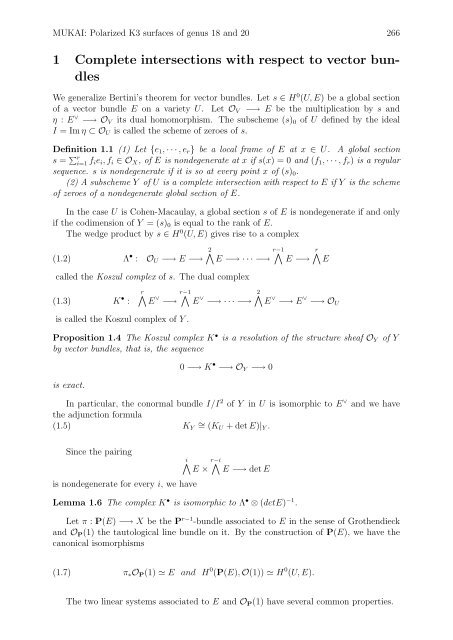Polarized K3 surfaces of genus 18 and 20 - Research Institute for ...
Polarized K3 surfaces of genus 18 and 20 - Research Institute for ...
Polarized K3 surfaces of genus 18 and 20 - Research Institute for ...
You also want an ePaper? Increase the reach of your titles
YUMPU automatically turns print PDFs into web optimized ePapers that Google loves.
MUKAI: <strong>Polarized</strong> <strong>K3</strong> <strong>surfaces</strong> <strong>of</strong> <strong>genus</strong> <strong>18</strong> <strong>and</strong> <strong>20</strong> 266<br />
1 Complete intersections with respect to vector bundles<br />
We generalize Bertini’s theorem <strong>for</strong> vector bundles. Let s ∈ H 0 (U, E) be a global section<br />
<strong>of</strong> a vector bundle E on a variety U. Let O V −→ E be the multiplication by s <strong>and</strong><br />
η : E ∨ −→ O V its dual homomorphism. The subscheme (s) 0 <strong>of</strong> U defined by the ideal<br />
I = Im η ⊂ O U is called the scheme <strong>of</strong> zeroes <strong>of</strong> s.<br />
Definition 1.1 (1) Let {e 1 , · · · , e r } be a local frame <strong>of</strong> E at x ∈ U. A global section<br />
s = ∑ r<br />
i=1 f i e i , f i ∈ O X , <strong>of</strong> E is nondegenerate at x if s(x) = 0 <strong>and</strong> (f 1 , · · · , f r ) is a regular<br />
sequence. s is nondegenerate if it is so at every point x <strong>of</strong> (s) 0 .<br />
(2) A subscheme Y <strong>of</strong> U is a complete intersection with respect to E if Y is the scheme<br />
<strong>of</strong> zeroes <strong>of</strong> a nondegenerate global section <strong>of</strong> E.<br />
In the case U is Cohen-Macaulay, a global section s <strong>of</strong> E is nondegenerate if <strong>and</strong> only<br />
if the codimension <strong>of</strong> Y = (s) 0 is equal to the rank <strong>of</strong> E.<br />
The wedge product by s ∈ H 0 (U, E) gives rise to a complex<br />
(1.2)<br />
Λ • :<br />
O U −→ E −→<br />
2∧<br />
E −→ · · · −→<br />
r−1 ∧<br />
E −→ r ∧<br />
E<br />
called the Koszul complex <strong>of</strong> s. The dual complex<br />
(1.3)<br />
K • :<br />
r∧<br />
E ∨ −→<br />
r−1 ∧<br />
E ∨ −→ · · · −→<br />
2∧<br />
E ∨ −→ E ∨ −→ O U<br />
is called the Koszul complex <strong>of</strong> Y .<br />
Proposition 1.4 The Koszul complex K • is a resolution <strong>of</strong> the structure sheaf O Y<br />
by vector bundles, that is, the sequence<br />
<strong>of</strong> Y<br />
0 −→ K • −→ O Y −→ 0<br />
is exact.<br />
In particular, the conormal bundle I/I 2 <strong>of</strong> Y in U is isomorphic to E ∨ <strong>and</strong> we have<br />
the adjunction <strong>for</strong>mula<br />
(1.5)<br />
K Y<br />
∼ = (KU + det E)| Y .<br />
Since the pairing<br />
i∧<br />
E ×<br />
r−i ∧<br />
E −→ det E<br />
is nondegenerate <strong>for</strong> every i, we have<br />
Lemma 1.6 The complex K • is isomorphic to Λ • ⊗ (detE) −1 .<br />
Let π : P(E) −→ X be the P r−1 -bundle associated to E in the sense <strong>of</strong> Grothendieck<br />
<strong>and</strong> O P (1) the tautological line bundle on it. By the construction <strong>of</strong> P(E), we have the<br />
canonical isomorphisms<br />
(1.7)<br />
π ∗ O P (1) ≃ E <strong>and</strong> H 0 (P(E), O(1)) ≃ H 0 (U, E).<br />
The two linear systems associated to E <strong>and</strong> O P (1) have several common properties.
















